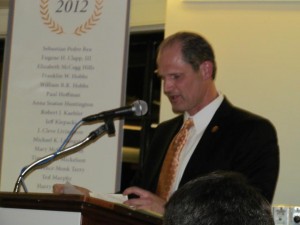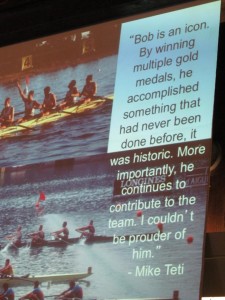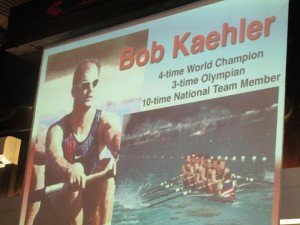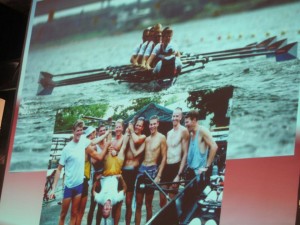National Rowing Hall of Fame – Class 2012
March 13, 2012
National Rowing Foundation inducts
Bob Kaehler into Rowing Hall of Fame
By Yasemin Watkins
On Saturday, March 10th, 2012, the National Rowing Foundation (NRF) inducted its Class of 2012 into the National Rowing Hall of Fame. The ceremony, held in Mystic Seaport, Mystic Connecticut, honored athletes for their excellence and service to the sport of rowing. Specifically, Bob Kaehler was honored for his accomplishments during his ten years (1991 to 2000) with the U.S. national team.
During this period, he was a finalist in two of his three Olympic appearances — the M8+ in Atlanta 1996 and Sydney 2000 — and won four World Championship titles (1994, 1997, 1998, and 1999). Kaehler still holds the record for most world championship titles won by an American in the M8+ event, and course records at the Royal Henley Regatta (Grand Challenge Cup — Fawley and the Barrier).
Other members of the honored Class of 2012 include Kaehler’s former crew mate and friend, Jeff Klepacki (national team member 1989 to 2003), as well as Jen Dore Terhaar, and twin sisters Mary McCagg and Elizabeth McCagg Hills.

Quick Speech
“It’s a great honor to be joining the National Rowing Foundation Hall of Fame,
and the company of such an accomplished group of rowing athletes,” said Kaehler.
“I truly appreciate the long-time athletic effort of all the rowers inducted before me,
as well as the effort the Foundation places in preserving our rowing history.”
While training as an athlete with the U.S. national team,
Kaehler trained with some of the world’s most successful rowing coaches including
Mike Spracklen (1994-1996) and Mike Teti (1997 – 2000).
“Bob Kaehler was a powerful athlete,” said Mike Spracklen, Coach of the Canadian Men’s National Team, and Kaehler’s coach during the Atlanta Olympics training cycle. “He had boat-moving skills he’d acquired from sculling, and was a welcome asset to our program.”
“His presence in the eight certainly contributed to its winning the World Championships in Indianapolis in 1994. It was the first time the US had won the world championships in the M8+ since 1987”
After the Atlanta 1996 Olympic games, Kaehler returned to training on the national team with new coach and old friend, Mike Teti.

HOF - Dinner Power Point Display
“I want to give my heartfelt congratulations to Bob on his well-deserved induction into the U.S.
Rowing Hall of Fame,” said Teti, head coach University of California’s Mens crew program. “Bob
has not only achieved on the international stage with his four gold medals, but has also
succeeded in building a business that now helps rowers of all levels accomplish their goals.”
“Most importantly, I have known Bob as a father, husband and friend,”
continues Teti. “In this arena he is truly a world champion.”
During his ten years on the national team, Kaehler raced with many of the most accomplished
rowers in U.S. history, including world and Olympic champions Bryan Volpenhein, and Chris
Ahrens.
“If you read the record books, you’ll see that Bob won a lot of big races — both sculling and sweep rowing,” said Chris Ahrens, world and Olympic Champion (Athlens 2004). “But what you won’t see, is that Bob was the heart and soul of the boats in which we rowed together. He was a generous leader and a great team mate.”
“Everyone learned a lot from him — about competing and about life,” said Ahrens. “I can’t think of a better Hall a Famer.”
The National Rowing Foundation is an organization dedicated to supporting athletes who pursue excellence in the sport of rowing. The Foundation’s primary goals include promoting the participation of the United States in international rowing competitions, preserving U.S. rowing history, and managing the National Rowing Hall of Fame.
Today, as Coach Kaehler, Bob Kaehler combines training as an elite athlete, with his training and experience as physical therapist and strength and conditioning specialist, to work with athletes of all levels, including world and Olympic champions. His signature approach is based on principles of Body Balance, which he integrates into all of his conditioning and corrective programs. Kaehler lives in Holland, Pennsylvania, with his wife Kim and their three young children.
Congratulations Bob!


1999 Men's 8+

Class of 2012 - Congratulation to All!
How are you finding more length in your rowing stroke?
March 8, 2012
By Coach Kaehler
Are you getting enough reach at the catch? Tired of your coach yelling at you to ‘get longer’, or fed-up with rigging yourself to row like you’re 6’8”? The fact is that the length of a rower’s stroke is a common concern for many rowing coaches. Coaches often single out rowers with shorter strokes and pressure them to produce more length. Over-reaching is one approach to increasing stroke length, but comes with an increased risk of injury. Other strategies include lowering feet, reducing footboard angles, changing spans and oars, etc. To increase their stroke length, many rowers try to get their shoulders, hips, or both further into the catch. While all of these options or a combination of them may seem ideal, alone, they aren’t effective solutions in the long term. More important, these ‘quick-fix’ solutions may actually place athletes in greater risks of injury. A more effective and long-term solution to increasing stroke length is to determine the athlete’s strength and flexibility deficits, and develop and implement an individual corrective program. Temporary rigging solutions can then supplement this program during the corrective transition.
A rower’s stroke length is primarily controlled by two factors: strength and flexibility. When both are in good balance, the athlete can get into a strong, powerful, and long position with little effort. While other considerations also influence stroke length — arm length, leg length, and torso length — these anatomical factors can not be altered. Instead, coaches and athletes use rigging changes to help modify stroke length, and improve uniformity in a crew with varying body types. However, using rigging strategies alone to correct possible deficits in a rower’s strength and flexibility is not the best long term solution, and can lead to increased risks of injury.
To effectively improve stroke length, I encourage coaches and athletes to first identify and correct individual strength and flexibility issues,and then explore possible rigging changes. Strength issues usually improve quicker than flexibility issues, so it may be several weeks or months before rowers should attempt to rig into a more advantageous position, as it relates to rowing power.
When stroke length is short at the catch, rowers often increase reach by increasing shoulder reach, hip reach, or both, with the later being the ideal if both are increased by the same amount. (Alternate sentence: When stroke length is short, rowers will try to lengthen by reaching further into the catch with their shoulders (most common approach), hips (preferred approach), or possibly even both.) While many rowers increase their length by reaching further into the stern with their shoulders while keeping their hips stable as they reach the catch, other more flexible athletes get too deep into the catch to find more length. However, because these athletes tend to be weak, this solution places them in a greater risk of injury because they get beyond their strength at the catch. These athletes often hit their Achilles’ tendon of calf with their seats, with knees well past vertical of the ankle joint at the catch. The relationship between the shoulder and hip joints should be set during the first third of the recovery. Once this relationship is set, it should remain unchanged for the remainder of the stroke, to and through the catch, and into the first half of the drive. Athletes who use the shoulder strategy to increase stroke length (compensating for strength and flexibility deficits), will have a less powerful rowing stroke and be more prone to injuries.
To understand the most powerful rowing stroke sequence, consider a heavy dead lift. With this lift, the hips must move first to get the weight moving. Then, as bar momentum builds, the back can then begin to isotonically work (shorten) in conjunction with the hips and knees. Using the shoulder strategy to increase stroke length alters the stroke sequence — the shoulders (instead of the hips) initiate the stroke movement, and therefore lead to a less powerful stroke.
Getting the hips deeper into the catch once the shoulder-hip relationship is set, is an excellent way to increase stroke length and power, especially when the changes in hip depth come from improvements in the athlete’s strength and flexibility. While changing the rigging (i.e. lowering feet or reducing foot angle) can increase stroke length, it reduces horizontal power in the stroke. A body-balanced approach to addressing and improving individual strength and flexibility deficits is the ideal solution to finding more stroke length, increasing boat speed, and reducing an athlete’s risk of injury.
Body Balance Evaluations – Marin Rowing Club – March 20th
March 4, 2012
Body Balance –Evaluation Process
Have you been dealing with chronic training related pain that has failed to get better with traditional medicine, or are you just looking to be faster, stronger, and more powerful?
One frustration with training is that most endurance athletes really do not understand what their strength and flexibility deficits are, or how to begin to correct them. Once you discover your deficits you can begin to correct them which will help you achieve a long, powerful, and balanced rowing stroke.
By going through this powerful Body Balance Evaluation Process you start training far more effectively which will increase your power and strength while at the same time improve your injury resistance.
This session includes Coach Kaehler’s comprehensive Body Balance Evaluation Process (BBEP), followed by a personalized program of easy-to-follow exercises that address and correct each of your structural issues. Body balance helps athletes row more powerfully and avoid injury by shifting stresses of the rowing stroke toward proper support muscles, and away from your low back and other joints. Use this simple, but highly effective process to improve your performance and enjoy rowing to your potential. For more information on the Body Balance Structural Evaluation process please go to the “Body Balance” page on the Coach Kaehler web site.
Individual Session: ($475) – 100 to 120 Minutes – Each evaluation is followed by a private session to review specific corrective body balance exercises. Each participant will receive their own Body Balance corrective exercise booklet which addresses identified strength and flexibility deficits. The booklet includes detailed instructions (pictures and text) on how to perform each movement.
Each Participant Gets:
- Individual Evaluation
- A Corrective Exercise Program Specific to Their Testing Results
- Email With Any Follow-up Questions
- Basic Summary of The Findings
To confirm your spot please email me at coachkaehler@gmail.com I will send you a PayPal Invoice to confirm your spot.
**Please contact Coach Kaehler immediately after your purchase to confirm your time slot.
TUESDAY MARCH 20th – TIME SLOTS (Marin Boathouse)
01:00pm – 03:00pm
03:00pm – 05:00pm
